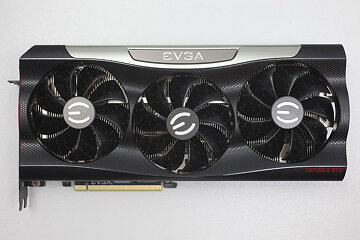 33
33
EVGA GeForce RTX 3090 FTW3 Ultra Review - The Quietest RTX 3090
Circuit Board Analysis »Packaging
The Card
EVGA has completely revamped their design language with the RTX 30 series. Instead of a transparent cooler shroud we now get classic black that's paired with silver metal highlights and a red trim. I have to say I really like the red even though it clashes a bit with NVIDIA's "green" color theme. On the back, you'll find a high-quality metal backplate.
Dimensions of the card are 30 x 14 cm.
Installation requires three slots in your system.
Display connectivity options include three standard DisplayPort 1.4a and one HDMI 2.1. Interestingly, the USB-C port for VR headsets, which NVIDIA introduced on the Turing Founders Editions, has been removed—guess it didn't take off as planned. The DisplayPort 1.4a outputs support Display Stream Compression (DSC) 1.2a, which lets you connect 4K displays at 120 Hz and 8K displays at 60 Hz. Ampere can drive two 8K displays at 60 Hz with just one cable per display.
Ampere is the first GPU to support HDMI 2.1, which increases bandwidth to 48 Gbps to support higher resolutions, like 4K144 and 8K30, with a single cable. With DSC, this goes up to 4K240 and 8K120. NVIDIA's new NVENC/NVDEC video engine is optimized to handle video tasks with minimal CPU load. The highlight here is added support for AV1 decode. Just like on Turing, you may also decode MPEG-2, VC1, VP8, VP9, H.264, and H.265 natively, at up to 8K@12-bit.
The encoder is identical to Turing. It supports H.264, H.265, and lossless at up to 8K@10-bit.
This BIOS switch lets you toggle between the normal (default) BIOS and an "OC" BIOS. Both BIOSes run the same clocks and voltages. The only difference is that "OC" has no fan stop and the fan curve is a bit more aggressive.
Near the back of the card, you'll find two pin headers. The first one is to provide an RGB signal to other components, so they can be synced with the graphics card RGB. The second one lets you connect a case fan to the graphics card, making it spin at the same rate as the GPU fans. Since the graphics card is the highest heat output in most computers, this makes a lot of sense—idle fan stop during browsing and productivity and fans running when gaming.
Unlike the NVIDIA Founders Edition card that introduces the new 12-pin power input, EVGA sticks to the industry standard 8-pin PCIe power inputs, but there are three of them. Combined with PCIe slot power, this configuration is rated for 525 W. At reference specifications, the RTX 3090 is already shipping with 350 W typical board power, which maxes out power draw of two 8-pin connectors and begins to feed heavily on the PCIe slot. The third 8-pin input, which adds 150 W, is hence much needed for this card to have any meaningful power headroom.
The GeForce RTX 3090 supports SLI and features a newer-generation NVLink bridge interface, which means you can't use your NVLink bridge from your Turing cards. Be warned that with Ampere NVIDIA isn't supporting SLI as in implicit multi-GPU (SLI as you know it), but explicit multi-GPU that's developed and supported by game/application developers. With multi-GPU game support being pretty much non-existent, this basically means SLI is dead. Perhaps creative and 3D modeling applications that support explicit multi-GPU can benefit from SLI.
Teardown
EVGA's heatsink uses a copper baseplate to spread the heat and six heatpipes that quickly move the heat away from the GPU.
The backplate is made out of metal and protects the card against damage during installation and handling. Note the heatpipes integrated in the backplate, and the thermal pads to soak up heat from the memory chips placed on this side of the card.
Apr 24th, 2025 06:04 EDT
change timezone
Latest GPU Drivers
New Forum Posts
- 3DMARK "LEGENDARY" (307)
- What are you playing? (23454)
- The TPU UK Clubhouse (26161)
- Are the 8 GB cards worth it? (122)
- Help me identify Chip of this DDR4 RAM (33)
- 5070 Ti power limit questions (61)
- any way to get past bios mismatch error? (2)
- AMD RX 9070 XT & RX 9070 non-XT thread (OC, undervolt, benchmarks, ...) (95)
- RX 9000 series GPU Owners Club (503)
- Help getting a mini pc (8)
Popular Reviews
- NVIDIA GeForce RTX 5060 Ti 8 GB Review - So Many Compromises
- Colorful iGame B860M Ultra V20 Review
- ASUS GeForce RTX 5060 Ti TUF OC 16 GB Review
- ASRock X870E Taichi Lite Review
- Upcoming Hardware Launches 2025 (Updated Apr 2025)
- Sapphire Radeon RX 9070 XT Pulse Review
- Sapphire Radeon RX 9070 XT Nitro+ Review - Beating NVIDIA
- NVIDIA GeForce RTX 5060 Ti PCI-Express x8 Scaling
- AMD Ryzen 7 9800X3D Review - The Best Gaming Processor
- ASUS GeForce RTX 5080 TUF OC Review
Controversial News Posts
- NVIDIA GeForce RTX 5060 Ti 16 GB SKU Likely Launching at $499, According to Supply Chain Leak (182)
- NVIDIA Sends MSRP Numbers to Partners: GeForce RTX 5060 Ti 8 GB at $379, RTX 5060 Ti 16 GB at $429 (127)
- NVIDIA Launches GeForce RTX 5060 Series, Beginning with RTX 5060 Ti This Week (115)
- Nintendo Confirms That Switch 2 Joy-Cons Will Not Utilize Hall Effect Stick Technology (105)
- Nintendo Switch 2 Launches June 5 at $449.99 with New Hardware and Games (99)
- Sony Increases the PS5 Pricing in EMEA and ANZ by Around 25 Percent (85)
- NVIDIA PhysX and Flow Made Fully Open-Source (77)
- Windows Notepad Gets Microsoft Copilot Integration (75)
















